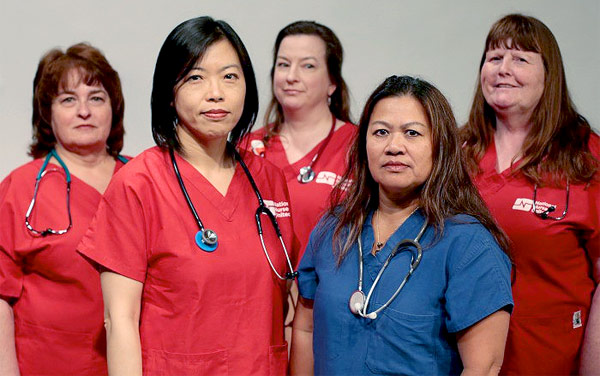Blog
Inhaling Toxic Smoke From Surgical Procedures Threatens Everyone in the Room

California RNs are fighting for better protections with reintroduction of “plumes” bill, A.B. 402.
Would you prefer to have surgery in an environment with sterile air—or in a room with air that may contain dangerous chemicals, cellular material, viruses, or bacteria? Most people would raise their hands for the former. Unfortunately, studies have shown that without proper ventilation, everyone in the vicinity during certain surgical procedures—from healthcare workers to the patients themselves—could be inhaling hazardous surgical smoke, or “plumes.”
“I worry about the potential danger,” said Fong Chuu, RN, who has worked in the operating room at UCLA Medical Center for 30 years. Chuu often provides care during procedures such as laser and electrosurgery, where devices used to cauterize vessels, destroy tissue, and cut bone create a smoke byproduct.
As nurses, of course, we appreciate that these procedures are less invasive, and therefore safer in many ways, for our patients. With every advancement in technology, however, we also know that it’s important to safeguard against any accompanying risks. And that brings us to surgical smoke, or plumes.
According to a 2016 study in the American Journal of Industrial Medicine, “surgical smoke has been shown to contain a variety of toxic gases, vapors, and particulates including carbon monoxide, polyaromatic hydrocarbons, benzene, hydrogen cyanide, formaldehyde, viable and non-viable cellular material, viruses, and bacteria.” That’s a long list of potential contents; exactly none of them should be inhaled by patients or healthcare workers.
The same study cites documentation of transmission of HPV, human papillomavirus, through surgical smoke. When inhaled, plumes can also lead to cancer, or viral infections resulting in acute and chronic pulmonary or skin disorders—including pneumonia, asthma, and other health hazards. Nationally, the Occupational Safety and Health Administration estimates 500,000 workers are exposed to the fumes every year.
“Sometimes, you get headaches from it, there’s an unpleasant odor, and your eyes get irritated,” said Chuu, who estimates that she is exposed to plumes roughly 25 to 30 hours a week. Chuu’s coworker Ashlee Perreault, RN—an OR nurse for 10 years—said she has noticed after certain procedures a tendency to suffer from coughing, a runny nose, or difficulty breathing.
Although evacuation devices have been shown to limit exposure, these devices may not be used often enough in all settings. A 2016 National Institute of Safety and Health (NIOSH) survey found that more than 4,500 of 12,000 healthcare workers reported exposure to plumes during laser or electrosurgery, yet only 47 percent of the respondents reported always using local exhaust evacuation (LEV) during laser surgery, and just 14 percent always used LEV during electrosurgery.
“Surgical plumes [result from] virtually all surgical cases since they come in multiple forms, not just from electrosurgical cautery or lasers, but other devices,” said Perreault, who believes healthcare providers need to do more to protect not just nurses—but anyone exposed. “Health hazards in regards to surgical plumes are imposed on the patients, as well.”
Chuu emphasizes that this is also an issue throughout the hospital, not just in the operating room.
“They perform these procedures in clinics, in the emergency room, in the intensive care unit, in the pediatric intensive care unit—and the air exchange rate is different there. There are stricter requirements for the operating room, so when we go to other sites to do these procedures, there is even less protection,” said Chuu. “I think it’s a public safety issue.”
California RNs Fight for Plume Protections
If you’ve never heard of “plumes,” and all this is news to you, you’re not alone. Too little public attention has been paid to this issue and that’s why nurses are standing up to say, “Enough.”
This month, California’s A.B. 402—authored by Assembly member Tony Thurmond, and sponsored by the California Nurses Association/National Nurses United (CNA/NNU)—was reintroduced in an effort to require the state to adopt rules to reduce toxic airborne contaminants. Specifically, A.B. 402 would direct California’s Occupational Safety and Health Standards Board to develop a strict standard to evacuate surgical plumes.
“I think it’s important to pass this bill, not only to ensure the safety of health professionals; we also have to think about patient safety,” said Chuu. Perreault agrees, pointing out that, “Plumes impact everyone in the room, period.”
The first hearing on this year’s bill is set for today, March 15, before the Assembly Labor Committee.
To the benefit of our patients, and all of the nurses and other healthcare workers who dedicate their lives to healing—we will fight hard to pass these commonsense protections. With a standard in place to evacuate plumes, we can all breathe a little easier.

Bonnie CastilloDirector of Health & Safety at @NationalNurses, Director of RN Response Network; I’m an RN & healthcare champion who believes healthcare is a human right!
